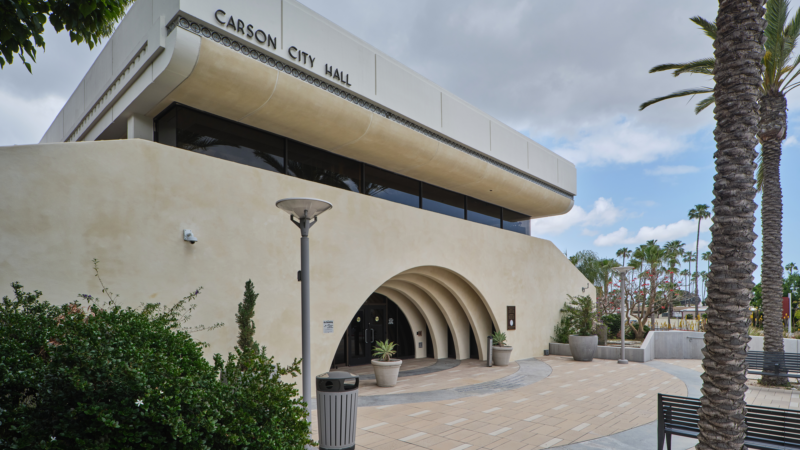Long ignored, Black modernist architects get recognition
Modernist structures designed by architects with recognizable names like Frank Lloyd Wright, Louis Kahn and Ludwig Mies van der Rohe dot the United States. These buildings are studied and praised for their “less is more” ethos, which incorporates building materials that were once considered modern — reinforced concrete, steel frames, and lots of windows and glass. If you’ve stepped into the Guggenheim Museum, you’ve been immersed in this style.
Others designed by Harvey Gantt, Charles McAfee and Walter Livingston Jr. use the same style but with one significant difference: those architects are Black. Historically, there have been few Black architects in the country, and even today, they comprise only 2% of licensed architects.
Often, their contributions to the architectural landscape have been overlooked.
Old buildings get new shine
Now, after years of being overshadowed, some buildings designed by Black modernists are finally being recognized. Architect Walter Livingston Jr. drew up the plans for Zion Baptist Church on the corner of Broad and Venango streets in North Philadelphia.
The grand structure, with its glass entrance and vaulted roof, is listed on the National Register of Historic Places. It was one of the first to receive a grant from The Conserving Black Modernism partnership between the Getty Foundation and the African American Cultural Heritage Action Fund in order to develop a preservation plan.
“We’re losing more and more buildings every day, and it’s important to recognize that history, record that history, and try to guard against its erasure,” says Brent Leggs, executive director of the African American Cultural Heritage Action Fund and senior vice president of the National Trust.

(Tema Nicole Stauffer | Getty Foundation)
The project to support the conservation of US buildings by Black architects began in 2022. It was an expansion of a Getty Foundation program that focused on modernist architects but did not include Black architects.
“We did not reach out proactively enough, and so this became the opportunity to do that,” says Joan Weinstein, director of the Getty Foundation.
The partnership provided $4.6 million over three years to preserve 24 modern sites across America.
Brian Goldstein, an architectural and urban historian who writes about the intersection of architecture and race, was asked to do a broad survey of modernist buildings designed by Black architects in the U.S.
Goldstein says he made a list of about 100 buildings, “a lot of really wonderful examples that would benefit from this kind of support.”
He was one of 10 people who reviewed the grant proposals and decided which structures met the criteria.
“A worthy building is one that is demonstrative of design quality in a way that is interpreted broadly,” Goldstein says.
“It’s not only the physical appearance. It’s the understanding of a building as being innovative architecturally. So certainly, form is part of that, but it might be the historical importance of the building or the designer. It also might be the building’s engagement with the community or where it sits among social ideals,” he says.
In 2023 and 2024, 16 structures created by 15 Black male and female architects won awards. They include churches, theatres, and a mosque and are located nationwide.
Preserving community gems
Michael Major is a reverend at Zion Baptist Church in Philadelphia. The church has been part of his life for decades.
“I went to day care here. I’m 63 now, so roughly, you’re talking about probably 60 years ago,” Major says. “I joined the church in the 1970s and spent all my free time in the post-day care building.”
The church, which seats 1,500 people, was packed in its heyday. Majors says congregants flooded to services dressed in their finest and crowded into the pale wood pews.
The airy space has a vaulted ceiling with red, green and blue stained glass windows, and there is wall-to-wall red carpet. Designed in the 1970s, Zion Baptist has started to show its age, and preserving a building with a rich history requires resources.
The grant funding allowed Major to hire preservation architect Kate Cowing to lead a historic preservation and stewardship plan for the main church building designed by Walter Livingston Jr. It’s only the first step a lengthy process to identify what the structure needs.
Some of the changes Cowing identified could be considered mundane, like upgrading all the bathrooms, rearranging offices, and reopening the basketball court.
However, to Cowing, “preservation is a community-building endeavor.” It makes people proud to live where they live. When neighborhoods are bulldozed, no one feels a sense of belonging or ownership.
“ It helps with the sense of place,” Cowing says .
The overlooked architects are finally getting recognition
Harvey Gantt is a modernist architect who designed the current First Baptist Church-West building in 1977. It’s recognized as the oldest Black Baptist church community in Charlotte, N.C.
Gantt is an award-winning architect, the first African American student admitted to Clemson University, and the first Black Mayor of Charlotte. In his 80s now, Gantt says as he looks back, he can reflect on the “audacity” he had to put in a bid to design the building.

(Tema Nicole Stauffer | Getty Foundation)
“We recognized that we were up against firms that had done nothing but churches,” Gantt says. “All of those firms were predominantly white firms, very good firms for that matter, but we said we want to compete.”
Gantt remembers being honest with the church board, saying that his firm had no record of designing or building churches, but his firm would study the church’s history to ensure they could implement the intended vision.
“The bottom line is we got the commission. And that was one of the biggest days for our firm,” he says proudly.
Gantt is still in disbelief that one of his buildings has received recognition. “ I was flattered. That anybody would remember anything I did,” he remembers thinking when he got the news.
“The church pastor, whom I’ve known for quite some years, called, and he says, ‘Guess what, Harvey, I’m not calling about a political matter. And I’m not calling about or complaining about something you did in the church years and years ago. I’m calling to tell you that we were just recognized.’ “

In Wichita, Kan., it was not a building but a swimming pool in a park that won recognition — the Charles McAfee Swimming Pool. McAfee’s pool, constructed in 1969, was one of the first municipal pools in Kansas to offer Black swimmers access to competition-length swimming lanes.
“McAdams Park was important to me. It was the only park Black people could go to when I was growing up,” says Charles McAfee, an award-winning architect who remembers playing there with friends.
“So, when I got the chance to build the pool, I used materials that would last forever. I relied mostly on concrete for the columns and brick walls. I wanted to use materials that I knew couldn’t be destroyed easily,” he says.
And 2025 is the last year for the Conserving Black Modernism partnership. More architects and eight structures will receive long-overdue accolades.
The grant program has also created peer-to-peer learning networks so the grantees can encourage the long-term care of threatened structures. These long-forgotten buildings still have stories to tell.
How this long-lost Chinese typewriter from the 1940s changed modern computing
The concepts in the MingKwai typewriter underlie how Chinese, Japanese and Korean are typed today. The typewriter, patented in 1946, was found last year in an upstate New York basement.
North Korea has a new luxury beach resort. But the country isn’t open to most tourists
North Korean leader Kim Jong Un said he wants the luxury resort on the eastern seacoast to become a "world destination," but the country has been reluctant to allow in foreign tourists.
Mariska Hargitay walks a fine line in ‘My Mom Jayne’
It's natural to feel some skepticism when a celebrity makes a documentary about their own family. But Law & Order star Mariska Hargitay' tells a story that is both effective and empathetic.
Ukraine says it struck a Russian airbase as Russia sent drones into Ukraine
Ukraine said it struck a Russian airbase on Saturday, while Russia continued to pound Ukraine with hundreds of drones overnight, dashing hopes for a breakthrough in efforts to end the war.
‘Buy now, pay later’ purchases can now affect your credit score. Here’s what that means
Services that split up payments into installments are increasingly popular, especially among young and low-to-middle income shoppers. But now the FICO credit scoring company will be tracking that debt.
Will Trump’s megabill help Democrats win the House?
Democrats feel that Trump's tax and spending bill gives them an opening ahead of the 2026 midterms. But if they want to win back the House, they're going to have to get their own house in order first.









